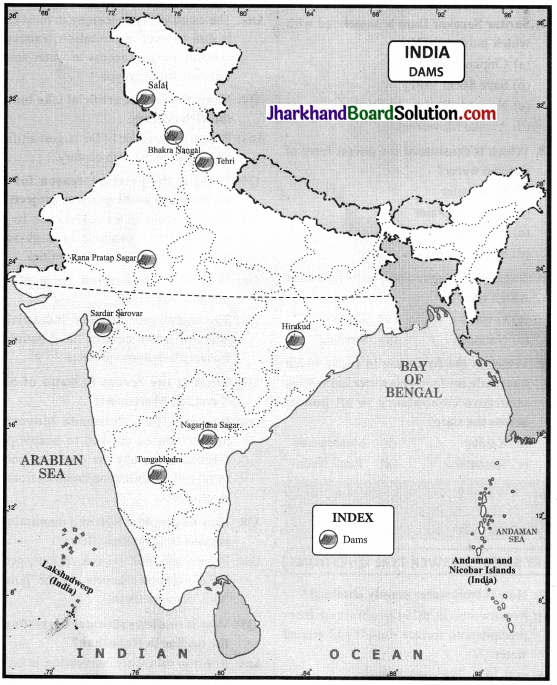JAC Board Class 10 Social Science Notes Geography Chapter 3 Water Resources
→ Three-fourth of the earth’s surface is covered with water but only a small proportion of it is freshwater that can be put to use.
- Freshwater is mainly obtained from precipitation, surface run-off and groundwater.
- Groundwater isTieing continually renewed and recharged through the hydrological cycle.
- It is predicted that by 2025 nearly two billion people will live in absolute water scarcity.
![]()
→ Water Scarcity7 and the Need for Water Conservation and Management
- The availability of water resources varies over time and space because of variations in seasonal and annual precipitation.
- Water scarcity in most cases is caused by over-exploitation, excessive use and unequal access to water among different social groups.
- Water scarcity may be due to outcome of large and growing population and consequent gfeater demands for water and unequal access to it.
- This means higher food grain production.
- This leads to exploitation of water resources to expand irrigated areas and dry-season agriculture. .
- Most farmers have their own wells and tube wells in their farms for irrigation to increase their produce. This may reduce the level of groundwater which may adversely affect the availability of water and food security of the people.
- The existing freshwater resources are under tremendous pressure from the ever- increasing number of industries, multiplying urban centres and urban lifestyles.
- Scarcity of water may also be due to bad quality of water. Water may be polluted by domestic and industrial wastes, chemicals, pesticides and fertilisers used in agriculture, thus, making it hazardous for human use.
- It is necessary to conserve and manage water resources to safeguard ourselves from health hazards, to ensure food security, continuation of our livelihoods and productive activities and to prevent degradation of natural ecosystems.
- Overexploitation and mismanagement of water resources will deplete this resource and cause ecological crisis which may affect our lives deeply.
→ Multi-Purpose River Projects and Integrated Water Resources Management
- Archaeological and historical records show that in the ancient times construction of sophisticated hydraulic structures, such as dams built of stone rubble, reservoirs, lakes, embankments and canals for irrigation.
- Traditionally dams were built to impound rivers and rainwater that could be used later for irrigating agricultural fields. These days dams are constructed not only for irrigation, but also for electricity generation, flood control, domestic and industrial water supply, fish breeding, inland navigation and recreation. They are now known as multi¬purpose river projects.
- The multi-purpose projects were launched after Independence with their integrated water resource management approach with aim of leading the nation to development and progress. Jawaharlal Nehru proclaimed dams as the‘temples of modem India’.
- However, multi-purpose projects have their disadvantages. These projects lead to sedimentation, which obstructs the natural flow, resulting in rockier stream beds; make it difficult for aquatic fauna to migrate, especially for spawning; submerge the floodplains and vegetation, leading to decomposition of soil over a period of time.
- Multi-purpose projects also lead to large- scale displacement of local communities, tearing them off of their livelihood and resources. Social movements like Narmada Bachao Andolan and Tehri Dam Andolan resist these projects.
- Irrigation has changed the cropping pattern as farmers have shifted to water-intensive cropping causing salinisation of soil.
- Inter-state water disputes have increased.
- These dams have triggered floods due to sedimentation in the reservoif, induced earthquakes, and caused land degradation, water-borne diseases, pests and pollution due to excessive use of water.
![]()
→ Rainwater Harvesting:
- Water harvesting is a viable alternative, both socio-economically and environmentally as compared to the multi-purpose projects.
- In ancient India, there had been sophisticated hydraulic systems of rainwater harvesting.
- People had in-depth knowledge of rainfall regimes, wide range of techniques to harvest rainwater, river water, flood water and recharge the groundwater sources, keeping in mind the ecological conditions and their water needs.
- In the mountainous regions, people built channels like ‘kuhls’ or ‘guls’ for agriculture. In Bengal, people developed inundation channels to irrigate their fields.
- In the arid and semi-arid regions ofRajasthan, farmers converted their agricultural fields into rain-fed storage structures that allowed the water to stand and moisten the soil like the ‘khadins’ in Jaisalmer and ‘Johads’ in other parts of Rajasthan. In Bengal, people carved out inundation channels to irrigate their fields.
- In Bikaner, Phalodi and Banner, Rajasthan, people had well-structured rooftop rainwater harvesting system which were connected with underground tanks or tankas for storing water also called ‘Palar pani’.
- This water was used during the dry season when there was scarcity of water.
- Today, in western Rajasthan plenty of water is available due to the perennial Indira Gandhi Canal.
- Gendathur, a remote backward village of Mysuru, Karnataka has earned the rare distinction of being rich in rainwater by practising rooftop rainwater harvesting system.
- Tamil Nadu is the first state to make rooftop rainwater harvesting compulsory to all houses across the state. There are legal provisions to punish the defaulters.
- Shillong in Meghalaya, 200-year old bamboo drip irrigation system is followed for irrigating plants.
